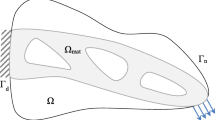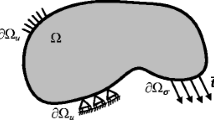Abstract
A topology optimization approach for designing structures with maximum energy absorption capacity under cyclic loads is proposed. To simulate the Bauschinger effect in materials under cyclic loads, Prager and the Armstrong-Frederick kinematic hardening rules are considered together with the von Mises plasticity in the optimization process. Path-dependent sensitivities are derived analytically using the adjoint method, which are further verified by the central difference method. Effectiveness of the proposed approach is demonstrated on several examples. Results show that the optimized designs with kinematic hardening are remarkably different from the ones obtained with isotropic hardening and are highly dependent on the loading patterns.


























Similar content being viewed by others
References
Armstrong PJ, Frederick C (1966) A mathematical representation of the multiaxial Bauschinger effect. Berkeley Nuclear Laboratories, Berkeley
Bendsøe MP, Kikuchi N (1988) Generating optimal topologies in structural design using a homogenization method. Comput Methods Appl Mech Eng 71(2):197–224
Bendsøe MP, Sigmund O (1999) Material interpolation schemes in topology optimization. Arch Appl Mech 69(9–10):635–654
Bendsøe MP, Sigmund O (2003) Topology optimization: theory, methods and applications, 2nd edn. Springer, Berlin
Bogomolny M, Amir O (2012) Conceptual design of reinforced concrete structures using topology optimization with elastoplastic material modeling. Int J Numer Methods Eng 90(13):1578–1597
Chaboche JL (1989) Constitutive equations for cyclic plasticity and cyclic viscoplasticity. Int J Plast 5(3):247–302
Christensen PW, Klarbring A (2008) An introduction to structural optimization, vol 153. Springer Science & Business Media, Springer, Netherlands
Crisfield MA (1997) Non-linear finite element analysis of solids and structures, volume 1: essentials. Wiley , West Sussex
de Souza Neto EA, Peric D, Owen DRJ (2011) Computational methods for plasticity: theory and applications. Wiley, West Sussex
Deaton JD, Grandhi RV (2014) A survey of structural and multidisciplinary continuum topology optimization: post 2000. Struct Multidiscip Optim 49(1):1–38
Ghabraie K, Chan R, Huang X, Xie YM (2010) Shape optimization of metallic yielding devices for passive mitigation of seismic energy. Eng Struct 32(8):2258–2267
Guo X, Zhang W, Zhong W (2014) Doing topology optimization explicitly and geometrically—a new moving morphable components based framework. J Appl Mech 81(8):081009
Jirásek M, Bazant ZP (2002) Inelastic analysis of structures. Wiley, West Sussex
Kasper EP, Taylor RL (1997) A mixed-enhanced strain method: linear problems. Department of Civil and Environmental Engineering. University of California, Berkeley
Kasper EP, Taylor RL (2000) A mixed-enhanced strain method: part I: geometrically linear problems. Comput Struct 75(3):237–250
Kato J, Hoshiba H, Takase S, Terada K, Kyoya T (2015) Analytical sensitivity in topology optimization for elastoplastic composites. Struct Multidiscip Optim 52(3):507–526
Kiran R, Khandelwal K (2014a) Complex step derivative approximation for numerical evaluation of tangent moduli. Comput Struct 140:1–13. doi:10.1016/j.compstruc.2014.04.009
Kiran R, Khandelwal K (2014b) A triaxiality and Lode parameter dependent ductile fracture criterion. Eng Fract Mech 128:121–138. doi:10.1016/j.engfracmech.2014.07.010
Kiran R, Khandelwal K (2015) A micromechanical cyclic void growth model for ultra-low cycle fatigue. Int J Fatigue 70:24–37. doi:10.1016/j.ijfatigue.2014.08.010
Kiran R, Li L, Khandelwal K (2015) Performance of cubic convergent methods for implementing nonlinear constitutive models. Comput Struct 156:83–100. doi:10.1016/j.compstruc.2015.04.011
Li L, Khandelwal K (2014) Two-point gradient-based MMA (TGMMA) algorithm for topology optimization. Comput Struct 131:34–45. doi:10.1016/j.compstruc.2013.10.010
Li L, Khandelwal K (2015a) An adaptive quadratic approximation for structural and topology optimization. Comput Struct 151:130–147. doi:10.1016/j.compstruc.2015.01.013
Li L, Khandelwal K (2015b) Topology optimization of structures with length-scale effects using elasticity with microstructure theory. Comput Struct 157:165–177. doi:10.1016/j.compstruc.2015.05.026
Li L, Khandelwal K (2015c) Volume preserving projection filters and continuation methods in topology optimization. Eng Struct 85:144–161. doi:10.1016/j.engstruct.2014.10.052
Li L, Zhang G, Khandelwal K (2017) Topology optimization of energy absorbing structures with maximum damage constraint. Int J Numer Methods Eng. doi:10.1002/nme.5531
Maute K, Schwarz S, Ramm E (1998) Adaptive topology optimization of elastoplastic structures. Struct Optim 15(2):81–91
Michaleris P, Tortorelli DA, Vidal CA (1994) Tangent operators and design sensitivity formulations for transient nonlinear coupled problems with applications to elastoplasticity. Int J Numer Methods Eng 37(14):2471–2499
Nakshatrala P, Tortorelli D (2015) Topology optimization for effective energy propagation in rate-independent elastoplastic material systems. Comput Methods Appl Mech Eng 295:305–326
Ohsaki M, Tagawa H, Pan P (2009) Shape optimization of reduced beam section under cyclic loads. J Constr Steel Res 65(7):1511–1519
Sigmund O, Maute K (2013) Topology optimization approaches. Struct Multidiscip Optim 48(6):1031–1055
Sigmund O, Petersson J (1998) Numerical instabilities in topology optimization: a survey on procedures dealing with checkerboards, mesh-dependencies and local minima. Struct Optim 16(1):68–75
Simo JC, Rifai M (1990) A class of mixed assumed strain methods and the method of incompatible modes. Int J Numer Methods Eng 29(8):1595–1638
Soong T, Spencer B (2002) Supplemental energy dissipation: state-of-the-art and state-of-the-practice. Eng Struct 24(3):243–259
Strang G (2007) Computational science and engineering, vol 1. Wellesley-Cambridge, Wellesley
Svanberg K (1987) The method of moving asymptotes- a new method for structural optimization. Int J Numer Methods Eng 24(2):359–373
Swan CC, Kosaka I (1997) Voigt-Reuss topology optimization for structures with linear elastic material behaviours. Int J Numer Methods Eng 40(16):3033–3057
Wallin M, Jönsson V, Wingren E (2016) Topology optimization based on finite strain plasticity. Structural and multidisciplinary optimization 54(4):783–793
Yan J, Guo X, Cheng G (2016) Multi-scale concurrent material and structural design under mechanical and thermal loads. Comput Mech 57(3):437–446
Zhang G, Li L, Khandelwal K (2016) Topology optimization of structures with anisotropic plastic materials using enhanced assumed strain elements. Struct Multidiscip Optim. doi:10.1007/s00158-016-1612-1
Acknowledgements
The presented work is supported in part by the US National Science Foundation through Grant CMS-1055314. Any opinions, findings, conclusions, and recommendations expressed in this paper are those of the authors and do not necessarily reflect the views of the sponsors.
Author information
Authors and Affiliations
Corresponding author
Appendix A: Elastic predictor/return-mapping algorithm and consistent tangent modulus
Appendix A: Elastic predictor/return-mapping algorithm and consistent tangent modulus
Numerical implementation of the von Mises plasticity considering mixed isotropic-kinematic hardening discussed in Section 3 is presented in this Appendix. In the context of strain-driven finite element formulation, with the given data at an integration point: ε p m , β m and α m at step m, and ε at current step m + 1, the goal is to find the unknown variables: ε p, β and α together with the consistent tangent modulus ℂ T at the current step. The consistent evaluation of the tangent operator ℂ T ensures the quadratic convergence of the global NR solver. Note that the subscript m + 1 of the variables at current step is omitted for the sake of clarity, also the step index is put at subscript instead of superscript, and the element number, integration point number are removed for clarity. The elastic predictor/return-mapping algorithm employed for solving the constitutive model is as follows:
-
Step 1:
Elastic (trial) step
Given:
$$ {{\boldsymbol{\varepsilon}}^p}^{tr}={\boldsymbol{\varepsilon}}_m^p,\ {\boldsymbol{\beta}}^{tr}={\boldsymbol{\beta}}_m,\ {\alpha}^{tr}={\alpha}_m $$Evaluate:
$$ \begin{array}{l}{\boldsymbol{\sigma}}^{tr}=\mathrm{\mathbb{C}}:\left(\boldsymbol{\varepsilon} -{{\boldsymbol{\varepsilon}}^p}^{tr}\right)\hfill \\ {}\mathrm{with}\ \mathrm{\mathbb{C}}=3\kappa {\mathrm{\mathbb{P}}}_{vol}^s+2\mu {\mathrm{\mathbb{P}}}_{dev}^s,\kappa = E/3\left(1-2\nu \right),\mu = E/2\left(1+\nu \right)\hfill \\ {} E\to\ \mathrm{Young}'\mathrm{s}\ \mathrm{Modulus},\nu \to \mathrm{Poisson}'\mathrm{s}\ \mathrm{Ratio}\hfill \end{array} $$(A1)\( {\left[{\mathrm{\mathbb{P}}}_{dev}^s\right]}_{ij kl}=\frac{1}{2}\left({\delta}_{ik}{\delta}_{jl}+{\delta}_{il}{\delta}_{jk}\right)-\frac{1}{3}{\delta}_{ij}{\delta}_{kl} \) and \( {\left[{\mathrm{\mathbb{P}}}_{vol}^s\right]}_{ij kl}=\frac{1}{3}{\delta}_{ij}{\delta}_{kl} \)
$$ \begin{array}{l}{\boldsymbol{\eta}}^{tr}={\boldsymbol{s}}^{tr}-{\boldsymbol{\beta}}^{tr}\mathrm{with}{\boldsymbol{s}}^{tr}={\mathrm{\mathbb{P}}}_{dev}^s:{\boldsymbol{\sigma}}^{tr}\hfill \\ {}{\zeta}^{tr}={K}^h{\alpha}^{tr}\hfill \\ {}{\phi}^{tr}\left({\boldsymbol{\sigma}}^{tr},{\boldsymbol{\beta}}^{tr},{\zeta}^{tr}\right)=||{\boldsymbol{\eta}}^{tr}|| - \sqrt{\frac{2}{3}}\left({\sigma}_y+{\zeta}^{tr}\right)\hfill \end{array} $$If ϕ tr ≤ 0, then the current step is elastic and the following elastic updates are made
$$ {\boldsymbol{\varepsilon}}^p={{\boldsymbol{\varepsilon}}^p}^{tr},\boldsymbol{\beta} ={\boldsymbol{\beta}}^{tr},\alpha ={\alpha}^{tr}\ \mathrm{and}\ \boldsymbol{\sigma} ={\boldsymbol{\sigma}}^{tr} $$(A2)$$ {\mathrm{\mathbb{C}}}_T=\mathrm{\mathbb{C}} $$(A3)where ℂ T is the consistent tangent modulus. Else, if ϕ tr > 0, then there is a plastic flow in this step and the algorithm proceeds to Step 2.
-
Step 2:
Plastic return mapping
In this step, the plastic flow is nonzero (γ > 0). Using backward Euler method, the flow rules in Eqs. (9), (10) and (12) or Eq. (13) are discretized as follows
$$ {\boldsymbol{\varepsilon}}^p={\boldsymbol{\varepsilon}}_m^p+\Delta \gamma \boldsymbol{n} $$(A4)$$ \boldsymbol{\beta} ={c}_1{\boldsymbol{\beta}}_m+{c}_2\boldsymbol{n} $$(A5)$$ \alpha ={\alpha}_m+\sqrt{\frac{2}{3}}\Delta \gamma $$(A6)where the parameters c 1 and c 2 depend on the type of kinematic hardening rule. For Prager kinematic hardening
$$ {c}_1=1,\ {c}_2=\frac{2}{3} H\varDelta \gamma $$(A7)while for Armstrong-Frederick kinematic hardening
$$ {c}_1=\frac{1}{1+\varDelta \gamma b},\ {c}_2=\frac{2}{3} H\frac{\varDelta \gamma}{1+\varDelta \gamma b} $$(A8)
The stress σ update can be written as
where μ is the shear modulus. The unknown variables are σ, β and Δγ, and the corresponding system of equations are
Furthermore, σ and β can be seen as functions of Δγ, which means that the above system of equations can be simplified to one equation which can be used to solve for Δγ. The NR method is used to solve F 3 = 0 with the Jacobian calculation as follows
The term \( d\alpha / d\varDelta \gamma =\sqrt{2/3} \) can be easily obtained from Eq. (A6). Given the expressions of c 1 and c 2 for different hardening rules, it is obvious that
-
For Prager linear hardening:
$$ \frac{\partial {c}_1}{\partial \varDelta \gamma}=0,\ \frac{\partial {c}_2}{\partial \varDelta \gamma}=\frac{2}{3} H $$(A12) -
For Armstrong-Frederick nonlinear hardening:
$$ \frac{\partial {c}_1}{\partial \varDelta \gamma}=-\frac{b}{{\left(1+\varDelta \gamma b\right)}^2},\ \frac{\partial {c}_2}{\partial \varDelta \gamma}=\frac{2}{3} H\left(\frac{1}{1+\varDelta \gamma b}-\frac{\varDelta \gamma b}{{\left(1+\varDelta \gamma b\right)}^2}\right) $$
With the Jacobian, Δγ can be obtained iteratively by solving Eq. (A10)3. Then a 0 can be computed, followed by which n, σ and β are sequentially determined.
Next, to compute the consistent algorithmic tangent modulus ℂ T (Kiran and Khandelwal 2014a), the stress tensor is decomposed as follows
Then the tangent modulus can be expressed as
where
The term \( d\varDelta \gamma / d{\boldsymbol{\varepsilon}}^{e^{tr}} \) can be obtained by differentiating Eq. (A10)3 as
and the term \( d\boldsymbol{n}/ d{\boldsymbol{\varepsilon}}^{e^{tr}} \) can be obtained as
Rights and permissions
About this article
Cite this article
Li, L., Zhang, G. & Khandelwal, K. Design of energy dissipating elastoplastic structures under cyclic loads using topology optimization. Struct Multidisc Optim 56, 391–412 (2017). https://doi.org/10.1007/s00158-017-1671-y
Received:
Revised:
Accepted:
Published:
Issue Date:
DOI: https://doi.org/10.1007/s00158-017-1671-y




